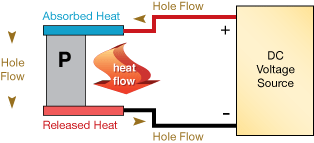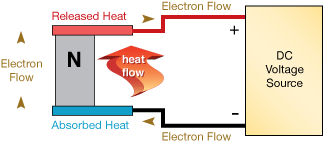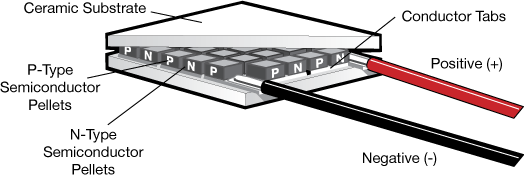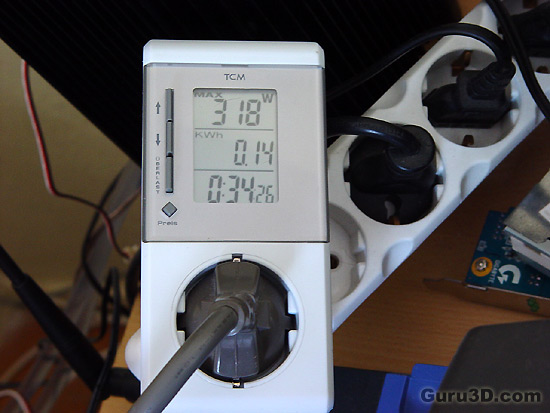Page 3
A quick 101 on Peltier cooling
If you want extreme cooling, a peltier can be what youre looking for. Basically it is a very small element that gets very cool, it can actually go WAY below zero which is dangerous with condensation in mind. And then there's this ... on the other hand, it gets really hot on the other side of the element and youll have to take away that heat with air-cooling or better. My biggest boggle was not the CPU getting too hot but the graphics card and the chipset on the motherboard. Heat stays in the case unless a fan-duct will remove the heat.
We know Peltier cooling under several names, TEC .. Peltier, thermo-electric cooling and di-electric cooling. It's all the same.


The Peltier effect occurs whenever electrical current flows through two dissimilar conductors; depending on the direction of current flow, the junction of the two conductors will either absorb or release heat. Explaining the Peltier effect and its operation in thermoelectric devices, is a very challenging proposition because it ultimately keys on some very complex physics. In the world of thermoelectric technology, semiconductors are the material of choice for producing the Peltier effectin part because they can be more easily optimized for pumping heat, but also because designers can control the type of charge carrier employed within the conductor. Using this type of material, a Peltier device (i.e., thermoelectric module) can be constructed in its simplest form around a single semiconductor 'pellet' which is soldered to electrically-conductive material on each end (usually plated copper). In this 'stripped-down' configuration, the second disimilar material required for the Peltier effect, is actually the copper connection paths to the power supply.

Le pouvoir "The Power"
We'll now show you some tests we have done on overall power consumption of the PC. Looking at it from a performance versus wattage point of view, the power consumption is not bad. Our test system is a Core 2 Duo X6800 Extreme Processor, the nForce 680i SLI mainboard, a passive water-cooling solution on the CPU, DVD-ROM and WD Raptor drive. Have a look
|
Videocard |
100% load |
System Idle |
|
BFG GTS 320 MB OC |
309 |
164 |
|
Calibre P880LV GTS 320 MB |
318 |
169 |
The methodology is simple: we look at the peak wattage during a 3DMark05 session with hefty IQ settings to verify power consumption. It's a good load test as both GPU and CPU are utilized really hard here. Please do understand that you are not looking at the power consumption of the graphics card, but the consumption of the entire PC.
We had a total system wattage peak at roughly 318 Watts for the Calibre card, which is a lot but not excessive. Other overclocked models run close to that number as well, so the Peltier unit is not chewing up too much wattage *phew*
We simply place a wattage meter in-between the PSU and power socket. It's not the most objective way to test as you have to consider PSU efficiency as well... it's the closest thing we can do though, and it measured pretty reliable and constant.
 |
||
Here's the Guru3D.com power supply recommendation for the GeForce 8800 GTS:
- A single GeForce 8800 GTS requires you to have a 450 Watt power supply unit at minimum if you use it in a high-end system. That power supply needs to have (in total) at least 26 Amps available on the 12 volts rails.
- A second GeForce 8800 GTS installed on this system requires you to have a 600 Watt power supply unit at minimum if you use it in a high-end system. That power supply needs to have (in total) at least 36 Amps available on the 12 volts rails.
There are many good PSU's out there, please do have a look at our many PSU reviews as we have loads of recommended PSU's for you to check out in there. What would happen if your PSU can't cope with the load?:
- bad 3D performance
- crashing games
- spontaneous reset or imminent shutdown of the PC
- freezes during gameplay
- PSU overload can cause it to break down
Les températures de la carte graphique
Right .. we have the MACs Peltier unit bitch slapped on top of that graphics card .. let's have a look at the temperatures. We measured at a room temperature of 22 Degrees C.
 |
||
Now a normal 8800 GTS 320MB card idles at roughly 50 Degrees C and can get 70-80 degrees C when fully utilized. The Peltier unit is definitely doing it's job here.
Despite the faster core frequency on the Calibre model temperatures were pretty darn cool. The card is idling at roughly 45 degrees C and at the highest temperature we measured with the GPU under full load was 58 Degrees C. Quite frankly this is really good compared over the standard NVIDIA cooler and that's puzzling me a little as our overclocks where quite bad. More on that later.
But cooling wise .. not bad. Does it make a lot of noise then ?
